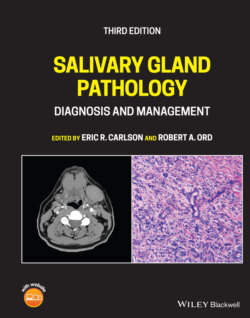Читать книгу Salivary Gland Pathology - Группа авторов - Страница 87
ACUTE SIALADENITIS
ОглавлениеAcute sialadenitis may be bacterial or viral in nature and may be a result of obstruction from a calculus, stricture or mass (see Chapters 3 and 5). Viral parotitis or mumps may be caused by a variety of viruses but most commonly the paromyxovirus is the culprit. The patient presents with an enlarged, tender, and painful gland. Acute suppurative parotitis (sialadenitis) presents in a similar manner as viral parotitis with the additional sign of purulent exudate. Oral bacterial pathogens are the causative agents, with staphylococcal and streptococcal species being the most common. CT scan demonstrates an enlarged gland with ill‐defined margins and infiltration of the surrounding fat by edema fluid. The gland, especially the parotid, is increased in density because of the edema fluid, which is of higher density than fat. CT contrast demonstrates heterogenous enhancement and may show an abscess. On T1 MRI scan, the overall gland signal may be decreased slightly from the edema but does enhance heterogeneously with contrast. T2 MRI scan shows increased signal secondary to edema. Both CT and MRI may demonstrate enhancement and enlargement of the parotid (or sublingual) duct. US shows slight decrease in echogenicity relative to normal. These patterns are not unique to bacterial or viral infection or inflammation and may be seen with autoimmune diseases such as Sjögren syndrome or a diffusely infiltrating mass. The surrounding subcutaneous fat also demonstrates heterogenous increased density from edema, resulting in a “dirty fat” appearance. There is also thickening of fascia and the platysma muscle (Shah 2002; Bialek et al. 2006; Madani and Beale 2006a).
Figure 2.52. Axial CT with contrast at the level of the masseter muscles demonstrating a left accessory parotid gland abscess.
With acute submandibular sialadenitis, the gland becomes enlarged and may be associated with a dilated duct if a sialolith is present. By CT, the calculus may be readily identified but not as easily seen by MRI. There may be varying degrees of cellulitis or frank abscess formation. The inflamed gland undergoes greater contrast enhancement. MRI demonstrates an enlarged heterogenous gland with dilated fluid‐filled duct and gland which on T2 images is of high signal. On ultrasound, the acutely inflamed gland demonstrates enlargement with focal hypoechoic foci (Shah 2002; Bialek et al. 2006; Madani and Beale 2006a), (Figures 2.52 through 2.54 ).
